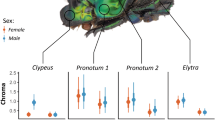Abstract
Field observations on the relationship between male mating success and emergence timing in the funnel-web spider,Agelena limbata, were conducted.Agelena limbata is an annual species and adult males appear slightly earlier than adult females in July. As males deposit a copulatory plug at the female epigynum after copulation, copulation with virgin females is important to males. The number of copulations in males with virgin females, which strongly correlates with the longevity of males and the number of females that males courted, did not correlate with the emergence timing of males. Early emerged males and females were significantly larger in size than later ones, but the correlation coefficient between the emerged date and the cephalothorax width was not strong. Males that emerged earlier did not have any advantage in copulating with larger and more fecund females. Furthermore, virgin females first copulated on average 7.9 days after their final molt and the mortality rate of adult males increased after the final molt. These factors may favor the smaller degree of protandry in male emergence timing inA. limbata.
Similar content being viewed by others
References
Austad S. N. (1982) First male sperm priority in the bowl and doily spider,Frontinella pyramitela (Walckenaer).Evolution 36: 777–785.
Christenson T. E. &Cohn J. (1988) Male advantage for egg fertilization in the golden orb-weaving spider,Nephila clavipes.Journal of Comparative Psychology 102: 312–318.
Gunnarsson B. &Johnson J. (1990) Protandry and moulting to maturity in the spiderPityohyphantes phrygianus.Oikos 59: 205–212.
Iwasa Y., Odendaal F. J., Murphy D. D., Ehrlich P. R. &Launder A. E. (1983) Emergence patterns in male butterflies: A hypothesis and a test.Theoretical Population Biology 23: 363–379.
Jackson R. R. (1980) The mating strategy ofPhidippus johnsoni (Araneae: Salticidae): II. Sperm competition and the function of copulation.The Journal of Arachnology 8: 217–240.
Jackson R. R. (1986) Cohabitation of males and juvenile females: A prevalent mating tactic of spiders.Journal of Natural History 20: 1193–1210.
Masumoto T. (1991) Male's visit to females' webs and female mating receptivity in the spider,Agelena limbata.Journal of Ethology 9: 1–7.
Masumoto T. (1993) The effect of the copulatory plug in the funnel-web spider,Agelena limbata (Araneae: Agelenidae).The Journal of Arachnology 21: 55–59.
Miyashita T. (1990) Decreased reproductive rate of the spider,Nephila clavata, inhabiting small woodlands in urban areas.Ecological Research 5: 341–351.
Miyashita T. (1993) Male-male competition and mating success in the orb-web spider,Nephila clavata, with reference to temporal factors.Ecological Research 8: 93–102.
Parker G. A. &Courtney S. P. (1983) Seasonal incidence: Adaptive variation in the timing of life history stages.Journal of Theoretical Biology 105: 147–155.
Turnbull A. L. (1962) Quantitative studies of the food ofLinyphia triangularis (Clerk) (Araneae: Linyphiidae).Canadian Entomologist 94: 1233–1249.
Turnbull A. L. (1965) Effects of prey abundance on the development of the spiderAgelenopsis potteri (Black-wall) (Araneae: Agelenidae)Canadian Entomologist 97: 141–147
Vollrath F. (1987) Growth, foraging and reproductive success. In:Ecophysiology of Spiders (ed. W. Nentwig) pp. 357–370, Springer-Verlag, Berlin.
Vollrath T. &Parker G. A. (1992) Sexual dimorphism and distorted sex ratios in spiders.Nature 360: 156–159.
Watson P. J. (1991) Multiple paternity and first mate sperm precedence in the sierra dome spider,Linyphia litigiosa Keyserling (Linyphiidae).Animal Behaviour 41: 135–148.
Author information
Authors and Affiliations
About this article
Cite this article
Masumoto, T. Male emergence timing and mating success in the funnel-web spider,Agelena limbata (Araneae: Agelenidae). Ecol. Res. 9, 159–165 (1994). https://doi.org/10.1007/BF02347491
Received:
Accepted:
Issue Date:
DOI: https://doi.org/10.1007/BF02347491




